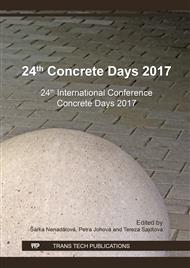[1]
Y. Ohama, Handbook of polymer-modified concrete and mortars properties and process technology, 1. ed., Park Ridge, N. J, Noyes Publications, (1995).
Google Scholar
[2]
D. Van Gemert, L. Czarnecki, M. Maultzsch, H. Schorn, A. Beeldens, P. Łukowski, E. Knapen, Cement concrete and concrete–polymer composites: Two merging worlds, Cement and Concrete Composites, 27 (2005), 9-10, pp.926-933.
DOI: 10.1016/j.cemconcomp.2005.05.004
Google Scholar
[3]
L. K. Aggarwal, P. C. Thapliyal, S. R. Karade, Properties of polymer-modified mortars using epoxy and acrylic emulsions, Construction and Building Materials, 21 (2007), 2, pp.379-383.
DOI: 10.1016/j.conbuildmat.2005.08.007
Google Scholar
[4]
P. Łukowski, Polymer-Cement Composites Containing Waste Perlite Powder, Materials, 10 (2016), 9, p.839.
DOI: 10.3390/ma9100839
Google Scholar
[5]
W. Malorny, M. Plath, Investigations on Properties Determining Durability of Novel PCC, Advanced Materials Research (2013), 688, pp.130-138.
DOI: 10.4028/www.scientific.net/amr.688.130
Google Scholar
[6]
B. Kucharczyková, H. Šimonová, D. Kocáb, Z. Keršner, Vývoj smrštění, hmotnostních úbytků a lomových parametrů vybraných polymer-cementových malt, Modelování v mechanice, 1. ed., Ostrava, 2017, pp.1-8.
Google Scholar
[7]
ČSN 73 1371 Nedestruktivní zkoušení betonu - Ultrazvuková impulzová metoda zkoušení betonu, Praha, ÚNMZ, (2011).
DOI: 10.51704/cjce.2016.vol2.iss1.pp76-82
Google Scholar
[8]
P. Cikrle, O. Anton, Vývoj nedestruktivních metod pro zkoušení betonu za posledních 25 let, Beton TKS, 3 (2015), pp.3-7.
Google Scholar
[9]
D. Kocáb, M. Králíková, P. Cikrle, P. Misák, B. Kucharczyková, Experimental analysis of the influence of concrete curing on the development of its elastic modulus over time, Mater. Technol. 51 (2017) 4, pp.657-665.
DOI: 10.17222/mit.2016.248
Google Scholar
[10]
V. Malhorta, A. N. Carino, Handbook on nondestructive testing of concrete, 2. ed., Boca Raton, CRC Press, (2004).
Google Scholar
[11]
ČSN 73 1372 Nedestruktivní zkoušení betonu - Rezonanční metoda zkoušení betonu, Praha, ÚNMZ, (2012).
DOI: 10.51704/cjce.2016.vol2.iss1.pp76-82
Google Scholar
[12]
Y. Zhou, J. Gao, Z. Sun, W. Qu, A fundamental study on compressive strength, static and dynamic elastic moduli of young concrete, Construction and Building Materials, 98 (2015), pp.137-145.
DOI: 10.1016/j.conbuildmat.2015.08.110
Google Scholar
[13]
P. Cikrle, D. Kocáb, Dynamické a statické moduly pružnosti betonu, TZB-info, 1 (2014), pp.1-8.
Google Scholar
[14]
ČSN ISO 1920-10 Zkoušení betonu - Část 10: Stanovení statického modulu pružnosi v tlaku, 2. ed., Praha, ÚNMZ, (2016).
Google Scholar
[15]
ZD Rpety-DAKEL, Diagnostická metoda akustické emise a její perspektivy, TECHMagazín, 3 (2011), pp.1-2.
Google Scholar
[16]
L. Pazdera, J. Smutný, P. Mazal, Využití metody akustické emise při sledování vlastností zatěžovaných materiálů a konstrukcí, Brno: Vysoké učení technické v Brně, (2004).
Google Scholar
[17]
M. Kreidl, R. Šmíd, Technická diagnostika: senzory, metody, analýza signálu, 1. ed., Praha, BEN - technická literatura, (2006).
Google Scholar
[18]
T. Suzuki, M. Ohtsu, Damage estimation of concrete canal due to earthquake effects by acoustic emission method, Construction and Building Materials, 67 (2014), pp.186-191.
DOI: 10.1016/j.conbuildmat.2014.05.016
Google Scholar


